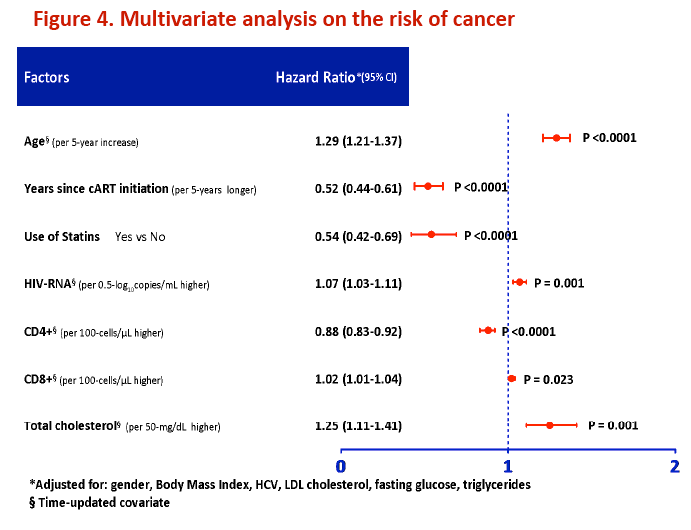 |
 |
 |
| |
Association between HMG-CoA reductase inhibitors (statins) use and cancer occurrence among HIV-1 treated patients - Statin use reduced incidence of cancers
|
| |
| |
Reported by Jules Levin
IAS 2013 Kuala Lumpur June 30-July 3
V.Spagnuolo1,2, L.Galli1, A. Poli1, L. Fumagalli1, N. Gianotti1, A. Carbone1,2, S. Nozza1, S.Bossolasco1, A. Lazzarin1,2, A.Castagna1
1 San Raffaele Scientific Institute, Infectious Diseases Department, Milan, Italy
2 Universita Vita-Salute San Raffaele,Faculty of Medicine and Surgery, Milan, Italy
AUTHOR CONCLUSION
This study showed, in a large number of treated HIV-infected subjects, that the use of statins was associated with a 46% reduction in cancer occurrence over a 10-year follow-up; this effect appeared to be even stronger in relation to the AIDS-defining malignancies which were not observed.
BACKGROUND
Statin use has been recently associated with reduced cancer incidence and mortality both in general population and among HIV-infected subjects1-3. Based on these encouraging results, we hypothesized that statin use begun after the start of the antiretroviral therapy and before a cancer diagnosis would be associated with reduced cancer occurrence.
METHODS
Retrospective longitudinal study on HIV-infected patients recorded in IDD-HSR (database of the Infectious Diseases Department, San Raffaele Scientific Institute, Milan, Italy), not on treatment with statin at antiretroviral therapy (ARV) initiation, cancer-free at ARV initiation and also at statin initiation, followed until October 2012. Follow-up was calculated since ARV initiation (baseline) until the first cancer diagnosis or loss to follow-up or death or last available visit, whichever occurred first. According to CDC-1993 classification, malignancies were divided into AIDS-defining (ADM) and non-AIDS-defining malignancies (NADM). Results described as median (IQR). Cox proportional hazard model was used to examine the effect of statin use on the risk of cancer, adjusting for potential confounders: age, gender, body mass index, HCV serology, ARV exposure, use of statins, HIV-RNA, CD4 and CD8 cell count, total cholesterol, LDL-cholesterol, fasting glucose, triglycerides.
RESULTS
Five thousand three hundred and fifty-seven patients followed for 10.3 (4.8-15.1) years. Patients' distribution and characteristics are reported in Figure 1 and Table 1 respectively.
During 52663 person-years of follow-up (PYFU), 375 (7%) patients developed cancer [ADM: 194 (52%); NADM: 181 (48%)]. During follow-up 740 (14%) patients used statin [duration: 24.7 (10.4-42.6) months]. Distribution of the type of statin among statin users is shown in the Figure 2.
Overall the crude cancer incidence rate was 7.1 (95%CI: 6.4-7.9) per 1000 PYFU [Statin users: 12 events, 9420 PYFU, incidence rate =1.3 (95% CI: 0.6-2.0); Non-Statin users: 363 events, 43243 PYFU, incidence rate=8.4 (95% CI: 7.5-9.3)] Cancer occurred in 12/740 (1.6%) statin users and in 363/4617 (7.9%) non-statin users (p<0.0001); all cancers among statin users were NADM. Malignancies distribution in the overall sample and according to statin use is described in Table 2, while the time to cancer occurrence according to statin use is shown in Figure 3. Finally, the results from multivariate analysis on the risk of cancer occurrence are reported in the Figure 4.






References
1. Nielsen SF et al. Statin use and reduced cancer-related mortality. NEJM, 2012; 367:1792-802
2. Chao C et al. HMG-CoA reductase inhibitors (statins) use and risk of non-Hodgkin lymphoma in HIV-positive persons. AIDS 2011: 25: 1771-7.
3. Overton E et al. The Effect of Statin Therapy in Reducing the Risk of Serious Non-AIDS-Defining Events and Non-Accidental Death. Clin Infect Dis 2013; Feb 5.
|
| |
|
 |
 |
|
|